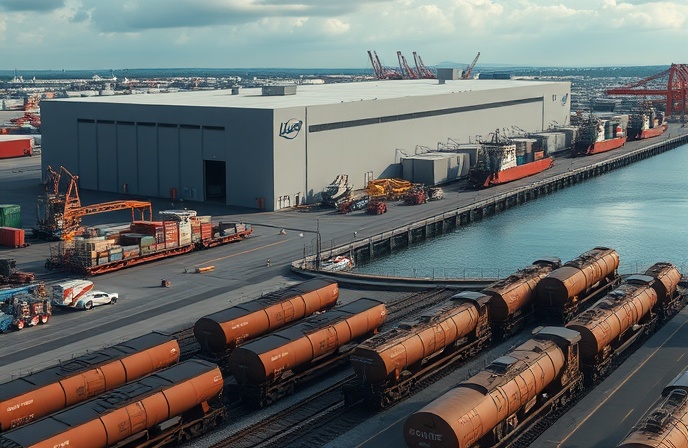TRAXX Electric Locomotives: Optimizing Global Rail Efficiency
Boost railway efficiency with advanced technologies, like intelligent train control systems and TRAXX electric locomotives. Discover how!

Optimizing Railway Efficiency: A Comprehensive Approach
The global railway industry is undergoing a period of significant transformation, driven by technological advancements, environmental concerns, and the increasing demand for efficient and reliable transportation solutions. This article explores key strategies for optimizing railway efficiency, focusing on the integration of advanced technologies, strategic infrastructure improvements, and the crucial role of skilled workforce development. From optimizing track maintenance to leveraging digital solutions, we will delve into practical approaches to enhancing railway operations and achieving sustainable growth within the industry. This analysis will shed light on the intricate connections between infrastructure, technology, and human capital, ultimately aiming to provide a comprehensive framework for maximizing railway productivity and minimizing operational costs. The article will examine various aspects of railway operations, including route optimization, maintenance schedules, and the utilization of advanced technologies, like intelligent train control systems, to streamline operations and enhance safety.
Infrastructure Modernization and Optimization
Modernizing railway infrastructure is paramount for achieving optimal efficiency. This involves upgrading track networks, incorporating advanced signaling systems (e.g., CBTC, ETCS), and constructing dedicated freight corridors to expedite freight traffic. Efficient signaling systems dramatically reduce delays by improving communication between trains and trackside infrastructure. Implementing robust track maintenance programs, encompassing predictive modelling and real-time monitoring, can minimize disruptions and improve operational reliability. Furthermore, the strategic placement of maintenance facilities and depots, taking into account traffic patterns and train scheduling, is essential for minimizing downtime and maximizing turnaround times.
Technological Integration for Enhanced Performance
Technological advancements offer significant opportunities to improve railway efficiency. Implementing intelligent train control systems (ITCS) allows for more precise scheduling, optimized train following, and reduced energy consumption. The integration of data analytics and machine learning can enable proactive maintenance, predicting potential failures before they occur and minimizing unexpected delays. Furthermore, advancements in telecommunications infrastructure allow for enhanced communication between train crews and dispatchers, streamlining the coordination of train movements and improving response times to unforeseen circumstances. The deployment of advanced monitoring systems for track conditions, such as sensors that detect anomalies in the rail or ballast, further contributes to preventing costly disruptions.
Skilled Workforce and Training Initiatives
A skilled and well-trained workforce is critical for operating and maintaining complex railway systems effectively. Investing in comprehensive training programs for railway personnel, covering advanced technologies and safety procedures, is essential for ensuring the safe and efficient operation of trains. Training programs should encompass the use of new signaling systems, digital control systems, and maintenance techniques. Moreover, fostering a culture of continuous learning and professional development among railway workers will ensure they remain up-to-date with the latest advancements and innovations. Recruitment and retention strategies should also target skilled technicians and engineers, ensuring a reliable and adaptable workforce.
The Role of Electrification and TRAXX Electric Locomotives in Sustainable Growth
Electrification of railway networks plays a vital role in reducing emissions and improving operational efficiency. Switching to electric locomotives, like the robust and reliable TRAXX electric locomotives, can significantly reduce operating costs and improve overall environmental performance. Electric traction offers substantial benefits in terms of reduced fuel consumption, lower emissions, and increased energy efficiency. A shift to electrifying existing lines and expanding the reach of electric traction can significantly reduce the carbon footprint of railway operations while enhancing operational efficiency. Implementing sophisticated energy management systems and integrating renewable energy sources into the charging infrastructure further strengthens the sustainability of railway operations.
Conclusion: A Synergistic Approach for Enhanced Railway Efficiency
Optimizing railway efficiency necessitates a holistic approach that considers infrastructure modernization, technological integration, workforce development, and the strategic deployment of advanced locomotive technologies. This article has highlighted the interdependence of these elements and emphasized the necessity of a collaborative effort among stakeholders to maximize the positive impact on operational efficiency and sustainability. By investing in advanced signaling systems, implementing intelligent train control, and developing skilled maintenance personnel, railway operators can significantly improve performance. This approach not only reduces operational costs but also significantly contributes to improved environmental sustainability, reflecting the pressing need for enhanced reliability and efficiency in modern transportation. The case for electrifying rail lines and adopting technologies like TRAXX electric locomotives further demonstrates the commitment to a sustainable future in the railway industry, recognizing the critical role of the workforce and advanced technologies in shaping the future of rail transportation. Investing in the future of the railway industry is not merely about upgrading infrastructure and implementing new technologies; it is also about fostering a skilled workforce capable of navigating and utilizing these innovations effectively and responsibly, ultimately creating a more efficient, sustainable, and reliable rail network for the future. This holistic approach ensures the railway sector can continue to meet growing transportation needs while minimizing environmental impact.
You might be interested in:



